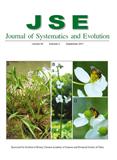Table of Contents
-

Volume 49 Issue 5
Cover illustration: Plants, inflorescences and pollinators in the aquatic monocot Sagittaria trifolia L. (Alismataceae). A, Transplanted individuals in a pond bank. B, A raceme showing that female fl owers in lower whorls bloomed earlier than male fl owers in upper whorls. C, A solitary bee (Halictidae: Lasioglossum) collecting nectar and pollen from a male flower. D, The Lasioglossum bee pollinating female flowers. Photographed by Shuang-Quan HUANG. See HAN et al., pp. 379–385 in this issue.
Editors-in-Chief
Song Ge
Jun Wen
Song Ge
Jun Wen
Impact Factor
3.7
JCR 2022 IF ranking: 60/238 (Plant Sciences, top 25%, Q2 quartile)
Journal Abbreviation: J Syst Evol
CN: 11-5779/Q
Frequency: Bi-monthly
Journal Abbreviation: J Syst Evol
| ISSN: | 1674-4918 (Print) 1759-6831 (Online) |
Frequency: Bi-monthly

Scan to view the journal on your mobile
device
device

Scan to follow us on WeChat







